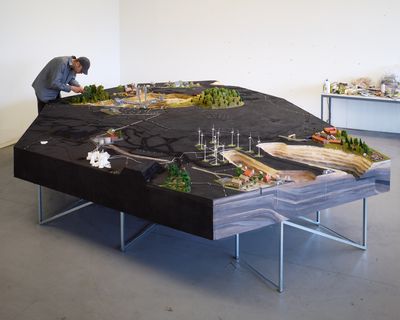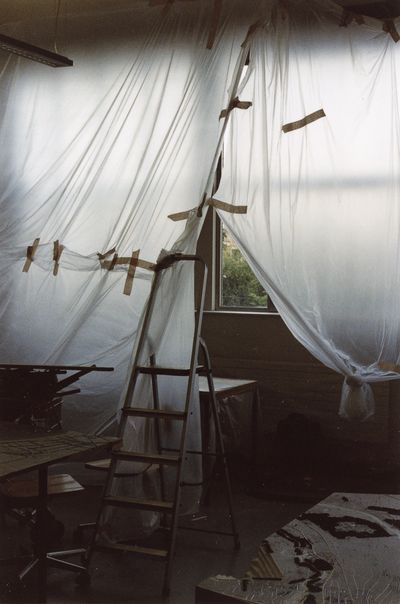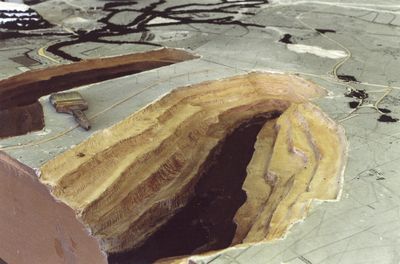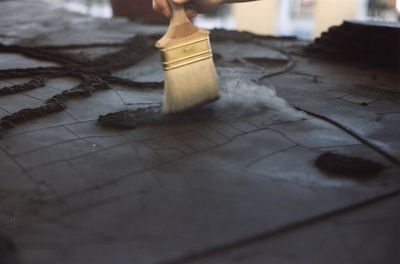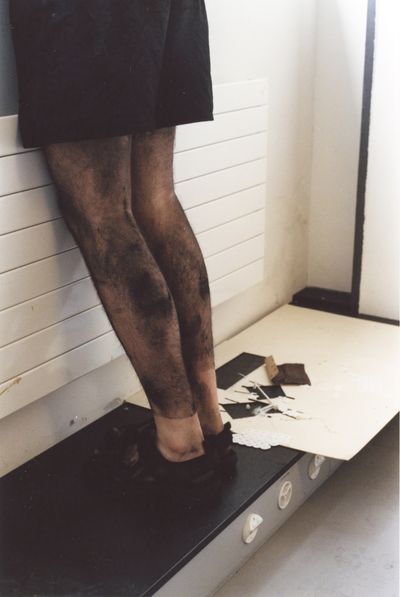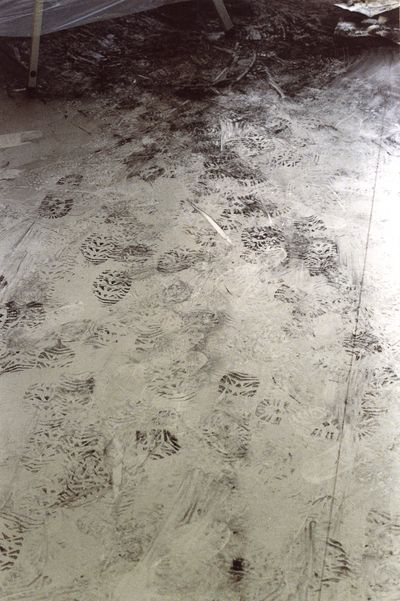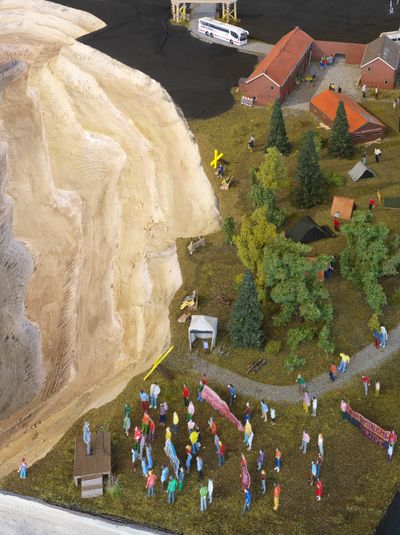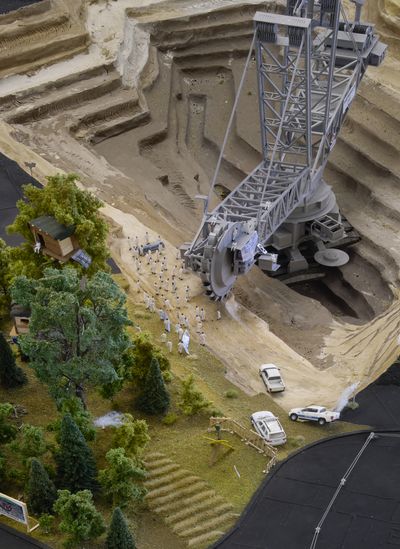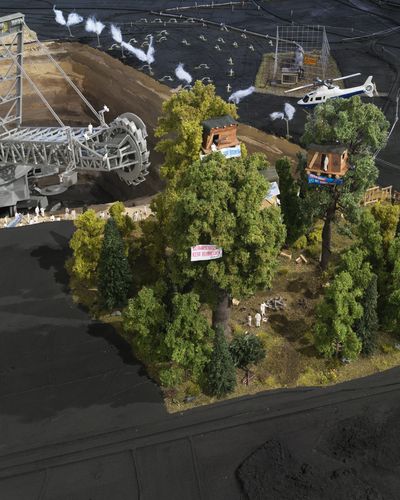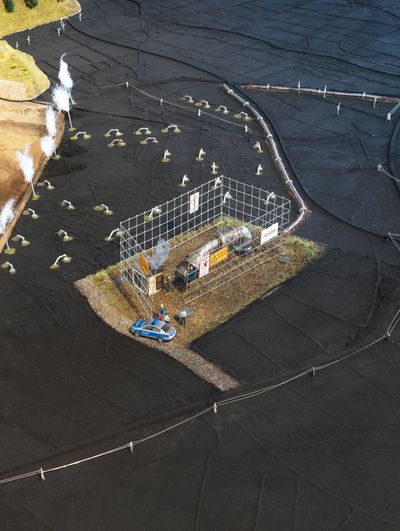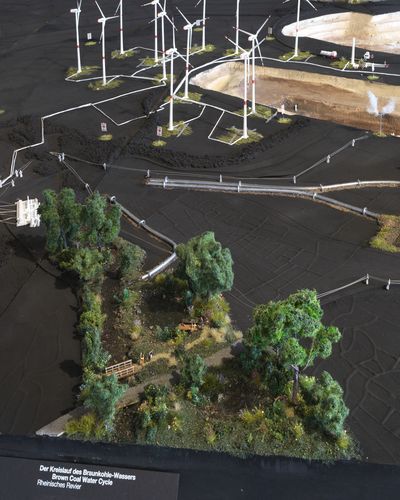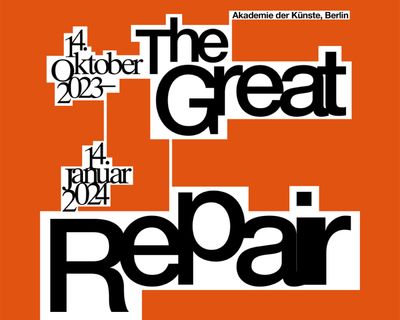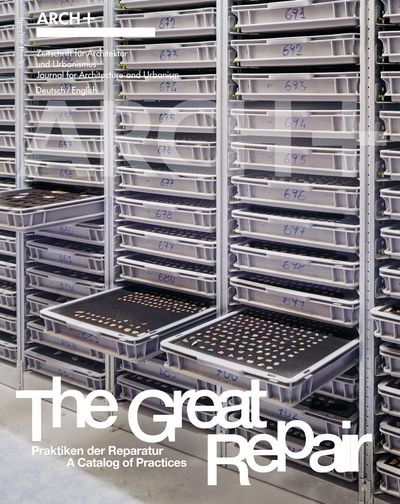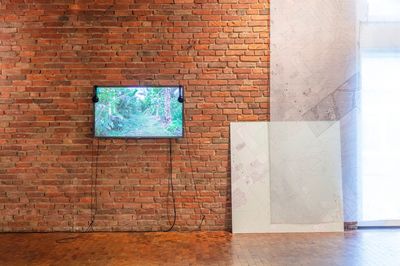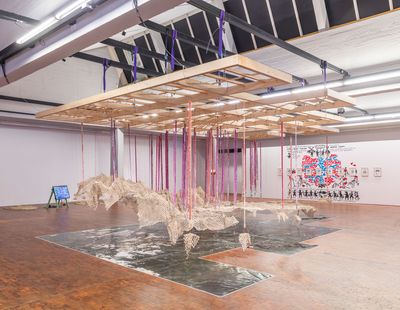Projects on Territory
Power to the People
Building a Common Model
In the Power to the People project, presented in the form of a territorial model, students of the chair of Architecture of Territory at ETH Zürich have portrayed stories of struggle as opportunities for a just energy transition and the social and ecological repair of the land. The model of the Rheinisches Revier, a 5,000 square kilometer coal mining region with a population of nearly 2.5 million residents, showcases miniature scenes illustrating stories of struggle for the social and ecological repair of the area.
Who owns energy sources and governs the energy transition? How can people mobilize for alternatives to fossil dependencies? There is no better place to ask these questions in Germany than the Rheinisches Revier, the region around the surface mine Tagebau Hambach, where the advancing coal mines and the desire for cheap energy have shaped the territory for over a century. The region has recently emerged as one of the battlegrounds of the global climate struggle, culminating in the occupation and eviction of the hamlet of Lützerath in early 2023.
The multinational energy corporation RWE (formerly the Rhein-Westfälische Elektrizitätswerke AG) governs all vital processes in the region, from geological structures to social realities and imaginaries, making it omnipresent in every aspect of life. Even as mining operations are being phased out in favor of renewable energy as part of Germany’s intended Kohleausstieg 2030, RWE remains in control of energy transition: In this corporate landscape, wind and solar parks are simply added to coal-fired power plants, based on the unchanged rationale of increasing profits that characterizes the extraction of coal. Fridays for Future, Alle Dörfer bleiben, and other activist and citizen organizations continue their struggle across the region, contesting the corporate greenwashing which deepens capital’s control of the land as well as perpetuates the interconnected crises of climate change, social polarization, cultural erasure, and ecological exhaustion. They demand not just an immediate exit from coal but also a democratically controlled and socially just transition to renewable energy. The world of ecological energy commons, democratically governed, can emerge. Power to the people!
Model Narratives
Morschenich-Alt: The Power of an Energy Corporation
To ensure the expansion of the open-cast mines, German mining law al- lows the energy corporation RWE to destroy entire landscapes, demolish villages, and relocate residents. The village of Morschenich-Alt had been slated for demolition since 1978; however, political pressure by various groups and the work of activists saved it from destruction in 2020. The prolonged uncertainty has led to the village’s near total depopulation, with resettlements continuing to this day. RWE remains in control of life in the village as the owner of all land and buildings; as an employer for the remaining inhabitants; and even as a public utility company provi- ding for the village’s heating–with brown coal.
Hambacher Forst: How to Save a Forest
Hambacher Forst is the remnant of a vast woodland that was gradually cleared to make way for the Hambach open-cast mine. Since 2012, the forest has been occupied by activists who helped bring public attention to its impending destruction. In addition to on-the-ground activism, several lawsuits were filed against RWE by the environmental association B.U.N.D. on behalf of Myotis bechsteinii, an endangered bat species pre- sent in the forest, and to object to the expropriation of a property owned by B.U.N.D. right at the edge of the mine. These strategies contributed to the rescue of the forest in 2020, when a federal agreement was reached to preserve it.
Lützerath: Networks of Resistance
Since the 1980s, to protect their villages, residents have been fighting the expansion of the Garzweiler open-cast mine with little to no attention from politicians and the media. Their struggle was noticed only in 2017, when climate activists from all over Europe occupied the endangered hamlet of Lützerath, turning it into a symbol of the global climate struggle. Lützerath served as a place of gathering and knowledge exchange for numerous activist groups, helping forge a connection between local movements and global networks of resistance. The hamlet of Lützerath was cleared by the police in January 2023.
Hambach Mine: The Lake Project and Limits to Renaturation
Once mining operations come to a projected end at the Hambach open-cast mine in 2030, groundwater will begin to slowly rise again, flooding the great crater in a natural process taking hundreds of years. The pressure to accelerate this process is high, as different actors wish to enable an economic exploitation of the artificial lakes. RWE plans to build underground pipelines from the Rhine to the pit, allegedly allowing it to fill up in only 40 years. This would create Germany’s second largest lake by volume. The feasibility of the project and its long-term environmental effects are severely disputed.
As owner of the land, RWE is also able to shape the nature of the post-mining landscapes. One example is Sophienhöhe, the world’s largest artificial hill, made up of excavated material from the Hambach open-cast mine. A new forest was planted to renature the hill and to compensate for the loss of the old forest. To date, RWE has reforested an area totaling about 80 square kilometers around Rheinische Revier, far short of what has been lost to the mines. Too compact and infertile to sustain a forest, the mineral substrate from the mining pit has to be enriched with nitrogen and topsoil over several years to create a sustainable soil for plants to grow.
Hambach Mine: How to Blow Up a Water Pump
Water infrastructure is integral to RWE’s brown coal extraction operations. To keep the mines dry, groundwater is tirelessly pumped out from a depth of over 500 meters through a network of more than 1,500 pumps. However, the drop in groundwater levels is not confined to the mines and their immediate surroundings. A so-called drawdown funnel centers on the mines, lowering the groundwater table as far away as in the Netherlands.
Activists in the region perceive the mines’ water drainage infrastructure as a symbol of RWE’s corporate exploitation of the region. Their resistance includes tactics such as setting fire to the power supply of groundwater pumps. By targeting the drainage infrastructure, they seek to disrupt the daily operations and processes of RWE, aiming to make a resounding statement against the company’s actions.
Rheinisches Revier: Brown Coal Water Cycle
After groundwater is pumped up to keep the mine dry, it is used to cool the power plants and to operate an extensive sprinkler system along the edges of the pit, intended to prevent the spread of dust. The supply of drinking water for the neighboring municipalities can no longer be guaranteed as aquifers run dry; instead, they become dependent on the supply of treated water provided by RWE. The impact of drainage extends to the regional wetland ecosystems which, to be preserved, must be artificially hydrated.
Königshovener Höhe: Controlling the Energy Transition
The wind farm at Königshovener Höhe is located on the recultivated lands of the Garzweiler open-cast mine. Devoid of vegetation and settlements, the post-mining landscape provides optimal conditions for the construction of wind farms. RWE maintains ownership of the land, enabling the company to build and manage its own wind turbines. In this way, the fossil energy corporation characterized by a questionable social and environmental record, secures its place as a leading protagonist of the energy transition.
